Transforming your backyard into an outdoor cooking paradise doesn’t require a celebrity budget or professional designer.
With a little creativity and planning, you can create an outdoor kitchen space that’s perfect for everything from casual family dinners to neighborhood gatherings that’ll be the talk of the town.
These outdoor kitchen ideas range from simple weekend projects to more ambitious setups, but all will dramatically increase your enjoyment of outdoor living.
✨Click to Get My 101 FREE Designer Room Ideas
The Ultimate Grill Station Command Center

Every great outdoor kitchen starts with a killer grill station, but the magic is in how you design around it.
A well-planned grill station becomes the command center of your outdoor entertaining space.
Start with choosing between built-in or freestanding grills based on your budget and commitment level.
Freestanding grills offer flexibility while built-ins create that permanent, high-end look that wows guests instantly.
Weather-resistant materials like concrete, stone, or specialized outdoor-rated countertops will stand up to the elements while looking fantastic.
Don’t forget to include storage underneath your grill counter for utensils, propane tanks, or charcoal.
Weatherproof cabinets or even simple curtained areas can hide supplies while keeping them easily accessible.
For evening cookouts, installing simple LED lighting around your grill area creates both ambiance and practicality.
Battery-operated or solar options make this upgrade possible without running electrical lines.
A small refrigerator near your grill station means fewer trips back to the house for condiments, marinades, or cold beverages.
Outdoor-rated refrigerators are designed to withstand temperature fluctuations and weather conditions your regular kitchen fridge would never tolerate.
Rosemary, thyme, and basil not only taste amazing in grilled dishes but also add a gorgeous visual and aromatic element to your cooking space.
A nearby trash and recycling station, disguised in a weather-resistant enclosure, completes your grill command center functionality.
With thoughtful planning, your grill station can become the heart of an outdoor kitchen that feels both luxurious and intensely practical.
The Stone Pizza Oven Experience

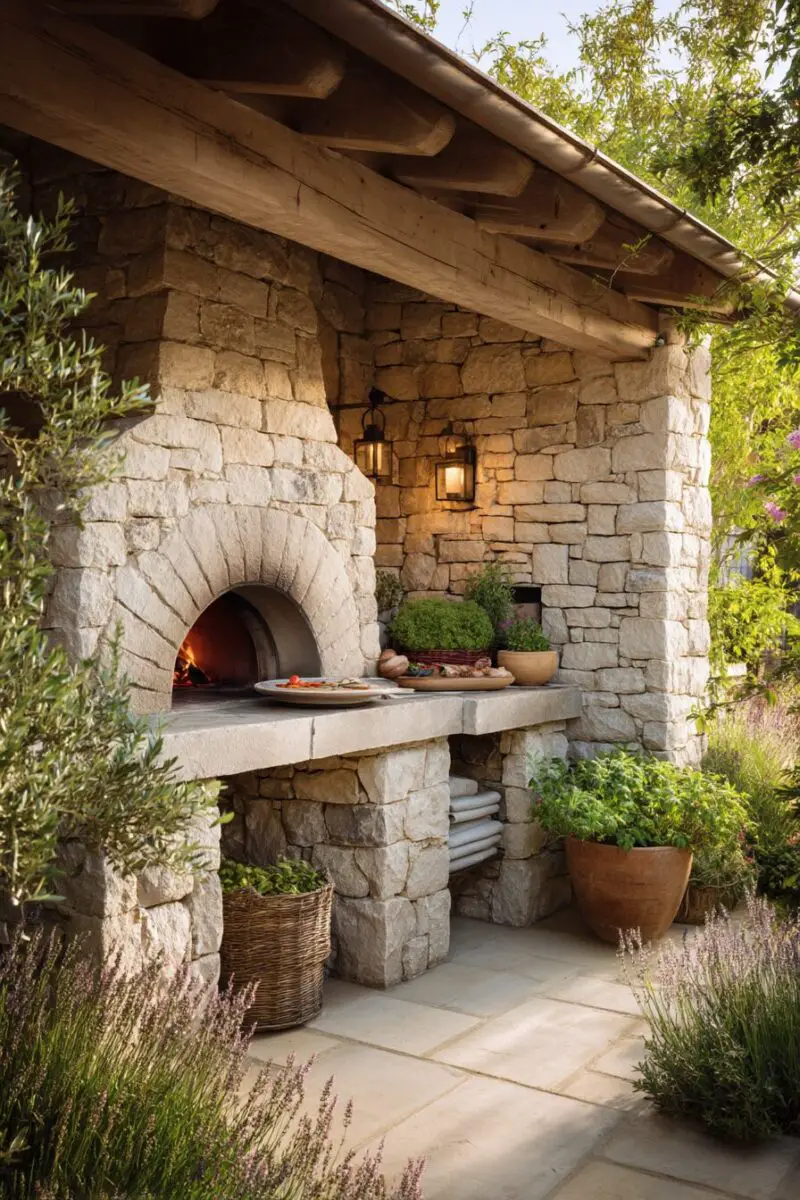
Nothing impresses backyard guests quite like pulling a perfectly crispy, bubbling pizza from your very own outdoor pizza oven.
The visual drama of a stone pizza oven creates an instant focal point that transforms your backyard into a rustic Italian escape.
Modern pizza oven kits have made this luxury item more accessible than ever, with options ranging from portable models to permanent installations.
The key to an amazing pizza oven experience is creating a dedicated space that accommodates the preparation process from start to finish.
Include a prep counter for rolling dough and adding toppings within arm’s reach of your pizza oven.
A small ingredient station with divided compartments for common pizza toppings keeps everything organized during the cooking frenzy.
Install simple shelving near your pizza oven for storing pizza peels, cutting boards, and other specialized tools.
Wood storage is another consideration – decorative wood storage not only keeps cooking fuel accessible but adds to the rustic aesthetic.
For serious pizza enthusiasts, consider a small refrigerator drawer specifically for storing dough and temperature-sensitive toppings.
Don’t forget seating that allows guests to watch the pizza-making process – the visual spectacle is half the entertainment value.
Surround your pizza oven area with herbs like oregano, basil, and rosemary that can go straight from plant to pizza.
Good lighting is essential for evening pizza-making sessions when you need to check if that crust is perfectly browned.
A pergola or partial roof over this area extends the pizza-making season through light rain or intense sun.
Your pizza oven zone should include space for serving and eating those fresh-from-the-fire creations while they’re still piping hot.
With proper planning, a backyard pizza oven becomes more than a cooking appliance – it becomes the centerpiece of outdoor entertaining.
The Social Island Hub
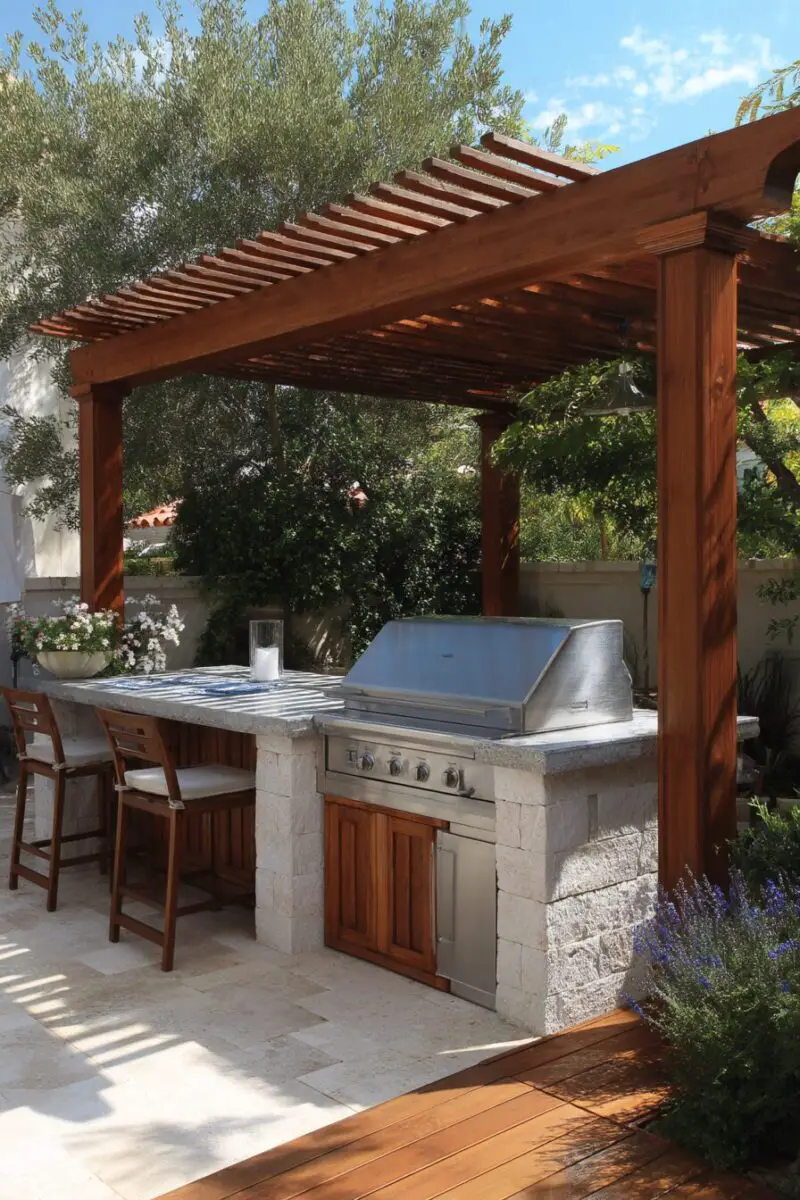
An outdoor kitchen island creates a natural gathering point that encourages conversation while you cook.
Unlike linear kitchen designs, islands allow your guests to surround you on all sides, creating a more interactive cooking experience.
The ideal outdoor island incorporates both cooking and socializing functions in one cohesive unit.
L-shaped or U-shaped islands maximize your working space while creating natural conversation pockets around the cooking area.
Materials matter tremendously for outdoor islands – concrete, stone, and specialized outdoor-rated surfaces withstand weather while looking sophisticated.
Powder-coated metal frames with stone tops offer durability with a modern aesthetic that fits contemporary backyard designs.
Include power outlets within your island design for blenders, slow cookers, or other small appliances that expand your outdoor cooking options.
Undercounter refrigeration transforms an ordinary island into a complete outdoor kitchen command center.
Strategic lighting installed underneath the island’s countertop edge creates a floating effect at night that adds serious wow-factor.
Built-in cutting boards or butcher block sections give you dedicated prep areas right where you need them.
Don’t forget to include trash management – a simple pull-out bin hidden within the island structure keeps garbage out of sight.
For small backyards, even a compact 4×4 island creates a functional cooking station without overwhelming the space.
The finishing touches matter – consider adding towel bars, tool hooks, or even a small herb garden integrated into the island structure.
With proper planning, your outdoor kitchen island becomes the social heart of your backyard, where cooking becomes a community activity rather than a solo chore.
The Rustic Brick & Stone Charm

There’s something timelessly appealing about the warm, earthy tones of brick and stone in an outdoor kitchen.
These natural materials instantly create a sense of permanence and connection to the landscape around your home.
Brick outdoor kitchens age beautifully, developing character and patina that only enhances their appeal over the years.
You can achieve this look without breaking the bank by using brick veneer or manufactured stone that mimics the real thing at a fraction of the cost.
A herringbone or basket weave brick pattern adds visual interest that elevates your outdoor kitchen design from basic to extraordinary.
For a truly rustic feel, incorporate reclaimed brick with its natural color variations and time-worn edges.
Stone and brick structures have the added advantage of thermal mass, which helps moderate temperature swings in your cooking area.
During hot summer evenings, these materials slowly release the day’s heat, creating a naturally comfortable cooking environment.
Mortar color makes a dramatic difference – dark mortar creates definition between bricks while light mortar creates a more unified look.
Don’t forget practical considerations – sealing your brick and stone surfaces prevents staining from food splatter and makes cleanup easier.
Incorporate wooden elements like cedar shelving or a butcher block section to soften the hardness of an all-masonry cooking space.
Climbing plants like jasmine or ivy can be trained to grow on brick walls, adding a living element to your outdoor kitchen.
Matching your brick outdoor kitchen to existing elements in your home’s architecture creates a cohesive design that looks purposeful rather than added-on.
The ultimate advantage of a brick outdoor kitchen is its ability to withstand decades of use with minimal maintenance – an investment that truly pays off over time.
✨Click to Get My 101 FREE Designer Room Ideas
The Covered Cooking Retreat
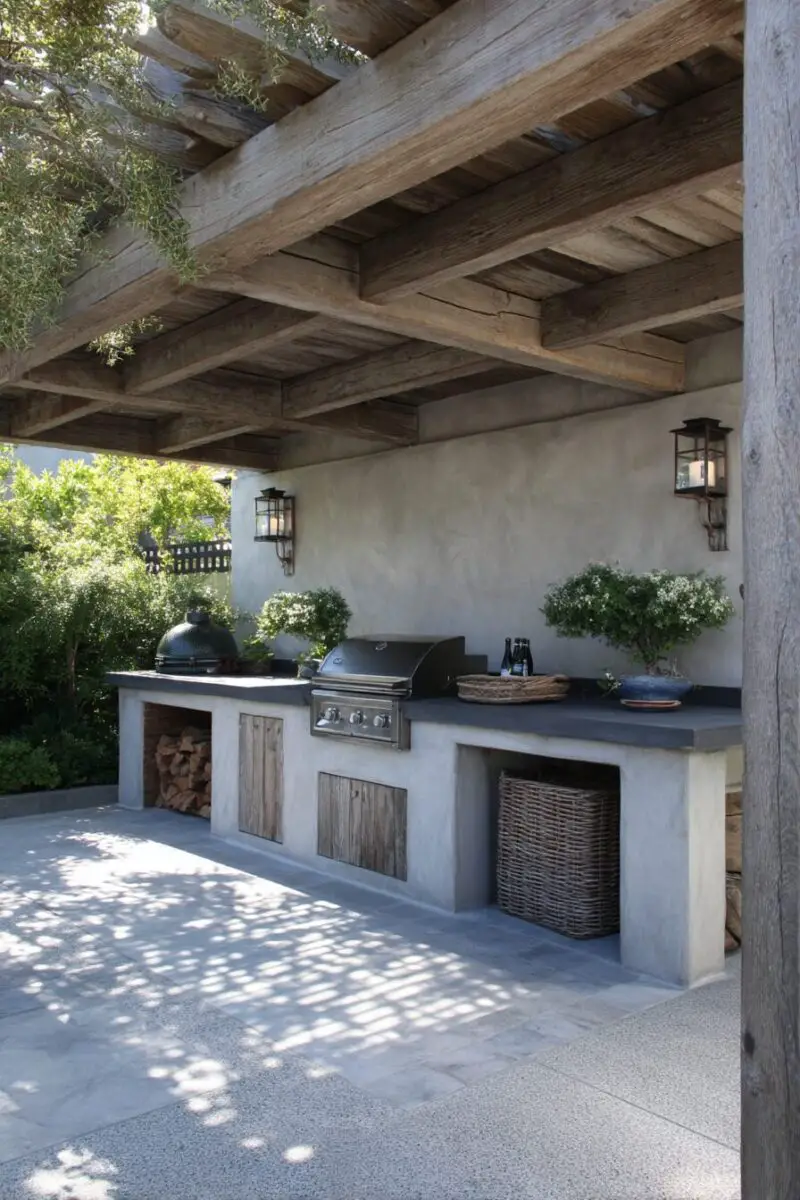
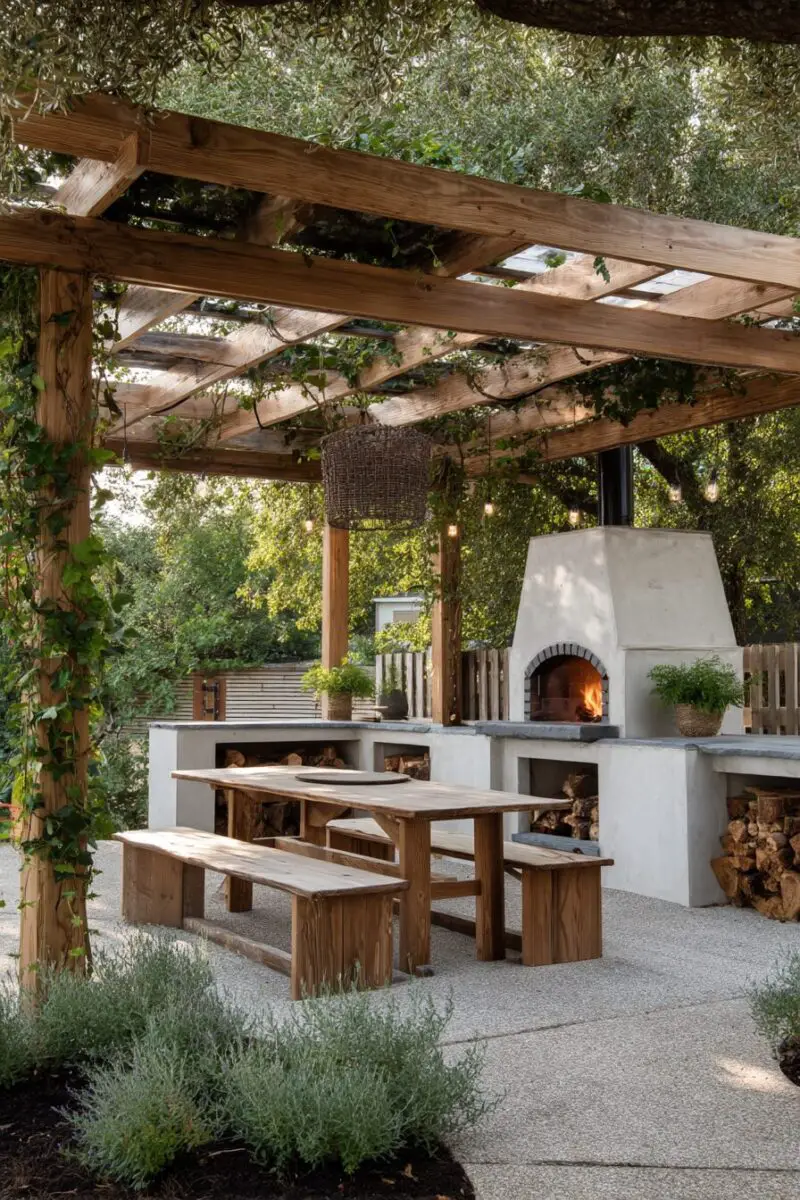
Extending your outdoor kitchen season requires protection from the elements, making a covered cooking area one of the smartest investments.
A well-designed roof over your outdoor kitchen transforms it from a fair-weather luxury to an all-season living space.
Permanent roof structures like extensions of your home’s existing roofline provide the most weather protection and visual integration.
For more flexibility, consider retractable awnings that can be extended during intense sun or light rain and tucked away when not needed.
Pergolas offer a middle ground, providing filtered sunlight while creating a defined architectural space for your outdoor kitchen.
Adding clear polycarbonate panels to pergola tops creates rain protection while still allowing natural light to filter through.
Strategic placement of your covered cooking area matters – position it to block prevailing winds and afternoon sun for maximum comfort.
Include proper ventilation in your covered outdoor kitchen design to prevent smoke buildup, especially if you’re using a grill under the structure.
Ceiling fans mounted to the covering not only provide cooling breezes but help disperse cooking smoke and odors.
Lighting becomes even more important in covered spaces – install task lighting over cooking areas and ambient lighting for eating zones.
Weatherproof speakers mounted to your overhead structure create an immersive entertainment experience during outdoor cooking sessions.
Remember that building codes often have specific requirements for covered structures, especially regarding clearance above cooking equipment.
For areas with heavy snow loads, ensure your outdoor kitchen covering is engineered to support significant weight during winter months.
The sides of your covered area can be left open for an airy feel or fitted with retractable screens to keep insects at bay.
With proper planning, a covered outdoor kitchen becomes your backyard’s most versatile space, usable from early spring through late fall.
The Budget-Friendly DIY Approach

Creating an impressive outdoor kitchen doesn’t have to drain your savings account if you’re willing to get creative with DIY solutions.
The secret to budget-friendly outdoor kitchens is using standard materials in unexpected ways that elevate their appearance.
Concrete blocks (CMUs) can be stacked and stuccoed to create the structure for an outdoor kitchen at a fraction of the cost of stone.
Concrete countertops mixed and poured yourself save thousands compared to granite or marble while offering similar durability.
Repurposed materials like reclaimed wood, salvaged brick, or industrial metal components add character while keeping costs down.
Old metal filing cabinets, properly sealed against the elements, make surprisingly effective and affordable outdoor kitchen storage.
A standard charcoal grill can be built into a surround of your own design, creating the look of a custom cooking station without the price tag.
Wooden pallets, when properly cleaned and sealed, can be transformed into everything from outdoor kitchen walls to seating areas.
Solar-powered lighting eliminates the need for expensive electrical work while still providing functional illumination for evening cooking.
Use exterior paint in bold colors to transform ordinary materials into eye-catching design elements that look intentional rather than cheap.
The humble cinder block, when stacked in creative patterns, can become modern-looking planters, benches, or even the structure for your grill station.
Vertical gardens created from rain gutters or PVC pipes provide fresh herbs for cooking while serving as living decoration for your DIY kitchen.
Tile remnants often available at deep discounts can create stunning countertop mosaics that add a custom, artistic touch to your space.
For storage solutions, weather-resistant plastic tubs hidden behind simple curtains offer functionality without the expense of custom cabinetry.
With some research, creativity, and elbow grease, your DIY outdoor kitchen can deliver champagne results on a beer budget.
The Multi-Level Design Experience
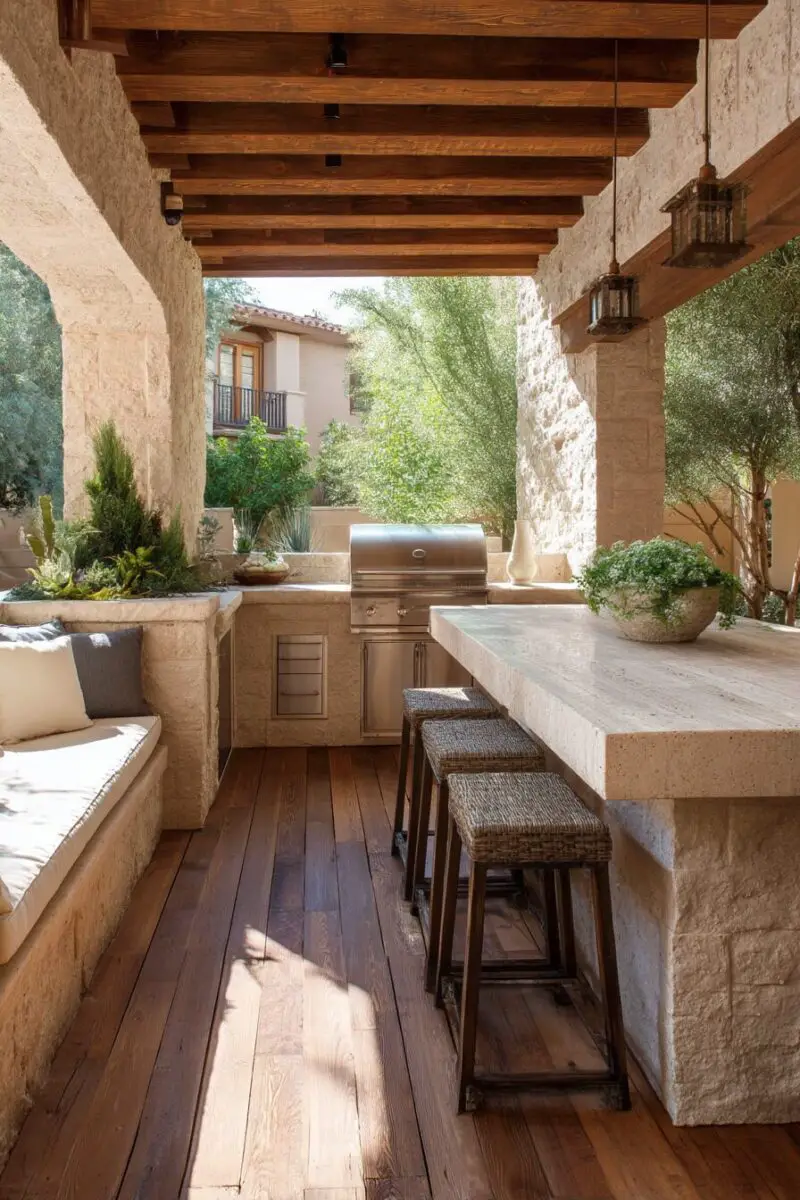
Breaking your outdoor kitchen into different levels creates visual interest while defining separate functional zones.
Multi-level designs transform flat, boring backyard spaces into dynamic cooking environments that naturally direct traffic flow.
Sunken seating areas adjacent to cooking zones create intimate conversation pits that still feel connected to the action.
Varying heights of countertops serve different functions – standard height (36″) for prep, bar height (42″) for casual dining.
Steps between levels can double as casual seating when lined with weather-resistant cushions.
Elevation changes as subtle as 8-12 inches create definition without requiring handrails or creating accessibility issues.
Retaining walls necessary for creating different levels double as built-in seating when topped with appropriate materials.
Different flooring materials can further accentuate level changes – perhaps stone for the cooking area, wood decking for dining zones.
Lighting installed at different heights emphasizes your multi-level design after sunset, creating dramatic shadows and highlights.
Built-in planters between levels soften transitions while adding greenery that enhances the outdoor experience.
Water features like small fountains or streams can be incorporated between levels, adding soothing sounds to your outdoor kitchen environment.
When designing multiple levels, always consider drainage – each level should have proper slope to prevent water pooling after rain.
For properties with natural slopes, working with the existing topography rather than against it creates more organic-feeling level changes.
Multi-level outdoor kitchens transform ordinary backyard cooking into an architectural experience that feels like a high-end resort in your own home.
The Beverage & Bar Station

A dedicated beverage station keeps drinks flowing without interrupting the cooking process or crowding the main kitchen area.
The perfect outdoor bar creates a natural secondary gathering spot that distributes guests throughout your backyard space.
Start with a countertop at bar height (42 inches) to create a comfortable leaning surface that encourages casual conversation.
Under-counter refrigeration specifically designed for beverages keeps drinks at perfect temperature while maximizing storage efficiency.
Ice makers are game-changers for outdoor entertaining, eliminating those last-minute runs to the store for bags of ice.
Built-in bottle storage and glass racks keep everything organized while creating visual interest through the display of colorful bottles.
Floating shelves mounted to a backing wall provide space for displaying specialty glasses, cocktail accessories, and decorative items.
For serious entertainers, consider a beer tap system connected to kegs stored in a specialized under-counter refrigerator.
Wine refrigerators with dual temperature zones accommodate both red and white wines at their optimal serving temperatures.
Adequate lighting above your bar area is essential – pendant lights not only illuminate the space but create ambiance.
Don’t forget to include convenient power outlets for blenders and other small appliances needed for cocktail preparation.
Weather-resistant storage for cocktail shakers, jiggers, and other bar tools keeps everything organized and protected from the elements.
A small herb garden adjacent to your bar provides fresh mint, basil, and other cocktail garnishes within arm’s reach.
With thoughtful design, your outdoor bar becomes more than just a place for drinks – it becomes a social hub that elevates your entire outdoor entertaining experience.
✨Click to Get My 101 FREE Designer Room Ideas
The International Cooking Pavilion
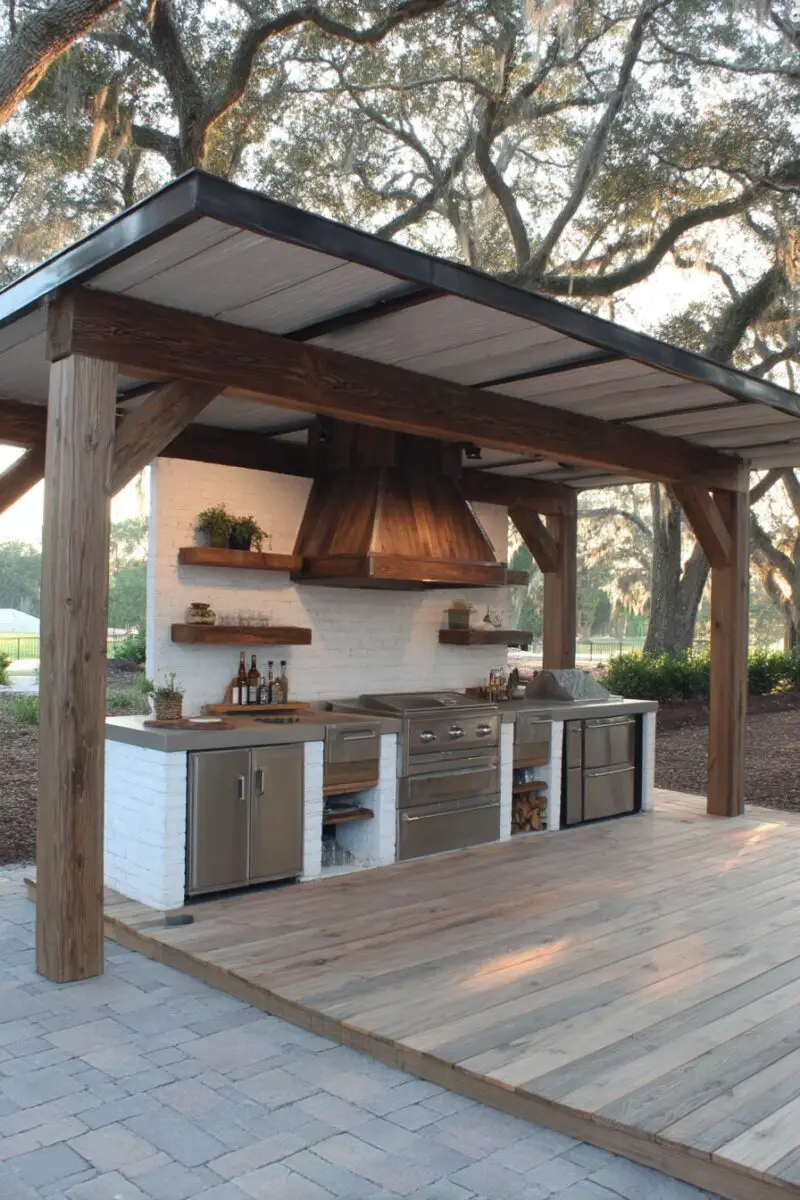
Transform your backyard into a global culinary adventure by designing an outdoor kitchen that accommodates cooking styles from around the world.
An international cooking pavilion lets you explore flavors beyond basic grilling, from Asian stir-fry to Latin American wood-fired specialties.
The key to this concept is incorporating multiple cooking methods within one cohesive outdoor kitchen design.
Start with a traditional grill as your base, then add specialized cooking equipment like a wok burner, tandoor oven, or Argentinian parilla grill.
A high-BTU outdoor wok station brings authentic Asian stir-fry capabilities to your backyard, requiring only a specialized burner and proper ventilation.
A vertical rotisserie, inspired by Middle Eastern shawarma or Mexican al pastor traditions, creates a dramatic cooking display while producing incredibly flavorful meats.
A plancha or flat-top griddle opens the door to Spanish, Mexican, and Japanese teppanyaki-style cooking with minimal space requirements.
Organize your international kitchen into cooking zones, each with appropriate prep space and tools specific to that culinary tradition.
Multi-level countertops accommodate diverse cooking heights – lower for rolling dough, standard height for chopping, higher for tending to wok cooking.
The Compact Space Solution

Limited backyard space doesn’t mean giving up on outdoor kitchen dreams – it just requires more strategic thinking.
Vertical design is the secret weapon for small spaces – build up rather than out to maximize functionality in minimal square footage.
Wall-mounted folding countertops can be deployed when needed and tucked away when you want to reclaim patio space.
Compact appliances designed specifically for small outdoor kitchens deliver functionality without the footprint of full-sized versions.
Corner installations maximize awkward spaces that might otherwise go unused in your small backyard.
Multi-functional elements are essential – look for grills with side burners and built-in storage to eliminate the need for separate structures.
Wheeled components give you flexibility to reconfigure your outdoor kitchen based on the specific needs of different gatherings.
Vertical herb gardens mounted to nearby walls or fences add greenery and cooking ingredients without consuming valuable floor space.
Look for nesting furniture and tools that can be compacted when not in use – expandable tables, stacking chairs, and collapsible serving carts.
Mirrors strategically placed on walls or fences create the illusion of more space while reflecting light into potentially shadowy corners.
Built-in seating around the perimeter of your small outdoor kitchen eliminates the need for space-consuming freestanding chairs.
Fold-down bars attached to walls or railings create instant serving and dining surfaces that disappear when not needed.
Hanging storage systems keep utensils, pots, and tools off your limited counter space while adding visual interest to walls.
Light colors for major surfaces make small outdoor kitchens feel bigger and brighter, especially in partially shaded areas.
With clever planning, even a postage-stamp patio can accommodate an outdoor kitchen that delivers big functionality in a small footprint.
Remember that plumbing and electrical requirements often make up a significant portion of outdoor kitchen costs – plan accordingly.
The most successful outdoor kitchens reflect your personal cooking and entertaining style rather than following generic design trends.
With careful planning and creative thinking, your outdoor kitchen will become the heart of your backyard – a place where memories are made around flames, food, and friendship.


